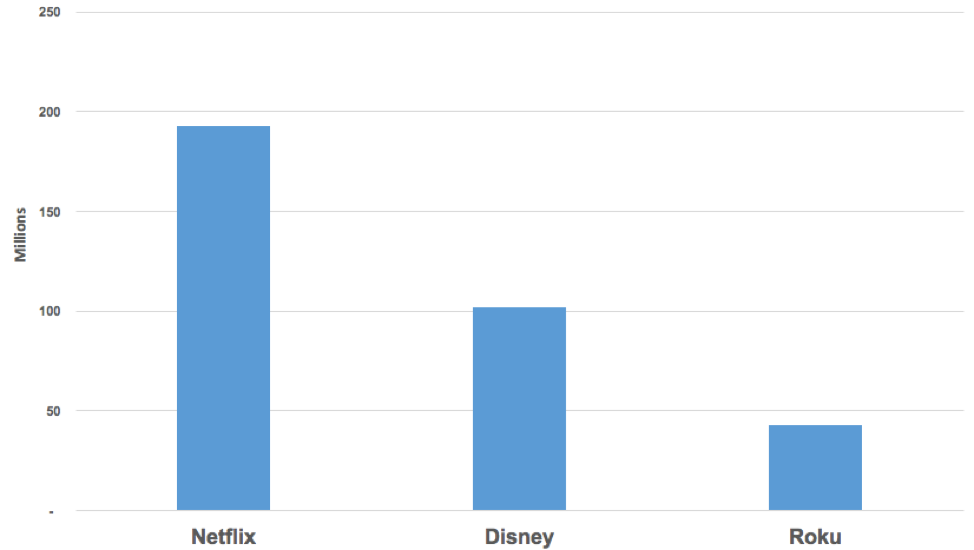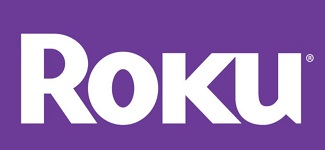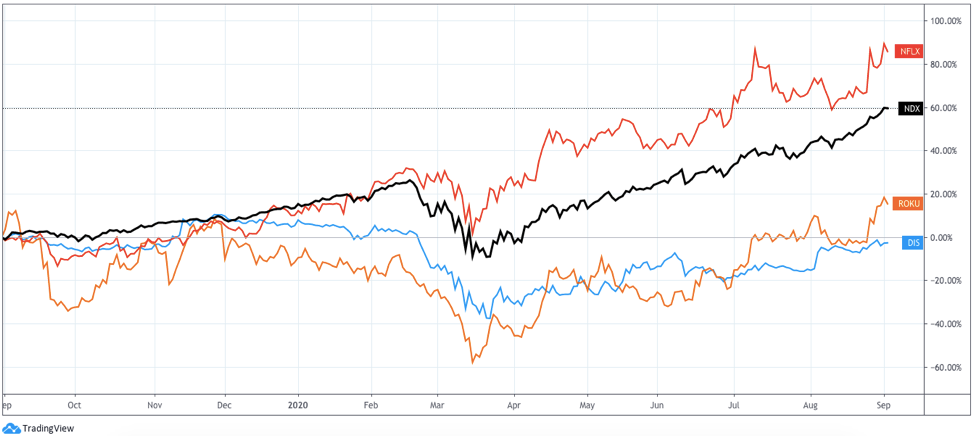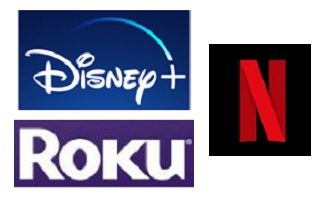eResearch | This past quarter, companies operating video streaming platforms including Netflix (NASDAQ: NFLX), Roku (NASDAQ: ROKU), and Walt Disney (NYSE: DIS), reported strong growth in new paid membership accounts as demand surged due to consumers staying home during the pandemic.
Netflix led the quarter with almost 200 million paid membership accounts, followed by Disney and Roku, with 102 million and 43 million paid membership accounts, respectively.
Netflix
 In Q2/2020, for the three months ended June 30, 2020, Netflix reported Revenue of $6.15 billion versus S&P Capital IQ analysts’ consensus estimate of $6.08 billion, with an EPS of $1.59 versus analysts’ estimate of $1.81.
In Q2/2020, for the three months ended June 30, 2020, Netflix reported Revenue of $6.15 billion versus S&P Capital IQ analysts’ consensus estimate of $6.08 billion, with an EPS of $1.59 versus analysts’ estimate of $1.81.
Netflix grew revenues by 25% year-over-year, driven by a surge in new memberships, a stronger demand from international markets and a continuous effort to develop and acquire new content.
Paid membership accounts reached 193 million as Netflix added 10 million new paid members this past quarter.
In an effort to offer more family-friendly shows with long-term appeal, Netflix is focusing investments on unscripted, reality TV shows, such as popular hits “Big Brother” and “Survivor”.
The Academy of Television Arts & Sciences recently issued nominations for the 72nd Emmy Awards, announcing 160 nominations for Netflix, which broke HBO’s record of 137 nominations from last year.
After pausing a majority of its original content production due to the pandemic, Netflix resumed production in several countries across the Asia-Pacific region and the Europe, Middle East and Africa regions. However, in the U.S., California and Oregon were the only two states that were back in production.
On the earnings call, Greg Peters, COO of Netflix, spoke on how production teams were adapting to COVID-19 impacts, and said,
“I think it’s been an opportunity to accelerate things that we were already excited about. One, I think, great example is creating a sort of technical infrastructure that allows distributed content creators, artists, think about visual effects artists, and animating artists, to be more effective when they’re at home, collaborating collectively on assets.
Ted Sarandos, Chief Content Operator of Netflix, who oversees content development and license acquisition, was promoted to co-CEO. Mr. Sarandos is expected to work alongside co-founder Reed Hastings, while also continuing past responsibilities as Chief Content Operator.
Netflix’s stock is currently trading at $542.86 per share, a 3% increase since the earnings announcement and an 85% increase in the past year.
Q3/2020 Guidance
- Revenue of $6.3 billion, Net Income of $954 million, and Diluted EPS of $2.09.
- Global Streaming Paid Memberships of 195 million.
- Global Streaming Paid Membership Net Additions of 2.5 million.
Disney

In FQ3/2020, for the three months ended June 27, 2020, Disney’s streaming segment, Direct-to-consumer and International, reported revenues of $3.97 billion. Disney’s Direct-to-consumer and International segment was its only business line to report positive revenue growth this past quarter.
Disney’s streaming platform, which includes Disney+, Hulu, and ESPN+, increased revenues by 2% year-over-year, driven by growth in new paid memberships, which was offset by a decrease in ad sales.
Paid membership accounts reached 102 million, mainly from Disney+, which makes up more than half of the accounts. Disney+ launched in November 2019, and was made available in North America, Western Europe, India, and Japan.
Disney received 145 nominations from the Academy of Television Arts & Sciences for the 72nd Emmy Awards, which includes 92 nominations from content produced by its own entities.
However, the pandemic paused the launch of key films, such as Disney’s highly anticipated Mulan, which was delayed multiple times. Mulan is expected to launch digitally on Disney+ this week for a price of $29.99.
Disney recently announced the expected launch of its new international-focused direct-to-consumer general entertainment platform under its Star brand in 2021. The new platform will not license any third-party content, but instead, will provide distributed content from owned assets such as ABC Studios, FOX Television, FX, Freeform, 20th Century Studios, and Searchlight.
International expansions are expected to continue for Disney+ this year, in locations such as the Nordics, Belgium, Luxembourg, Portugal, and Latin America. By the end of this year, Disney+ is expected to be available in nine of the top 10 economies in the world.
Bob Chapek, CEO of Disney, said,
“Let me reiterate that we see tremendous opportunity in the direct-to-consumer space. And in light of the success that we’ve achieved thus far with our global DTC business – and bolstered by our ability to deliver the exceptional brands, franchises and storytelling that consumers around the world have demonstrated a tremendous affinity for – we intend to take full advantage of that opportunity.”
Disney’s stock price is currently trading at $134.03 per share, a 14% increase since the earnings announcement and a 1.6% decrease in the past year.
FQ4/2020 Guidance (Direct-to-consumer & International segment)
- Revenue of $4.1 billion.
- Net Loss of $1.1 billion.
CHART 1: Q2/2020 Paid Membership Accounts – Netflix, Disney, and Roku

Roku
 In Q2/2020, for the three months ended June 30, 2020, Roku reported Revenue of $356 million versus S&P Capital IQ analysts’ consensus estimate of $314 million, with an EPS loss of $0.35 versus consensus estimate of $0.53.
In Q2/2020, for the three months ended June 30, 2020, Roku reported Revenue of $356 million versus S&P Capital IQ analysts’ consensus estimate of $314 million, with an EPS loss of $0.35 versus consensus estimate of $0.53.
Roku experienced a 41% increase in revenue year-over-year, attributed to high demand for its Player and TV products, strong subscriber growth for its streaming platform, and new offerings from its advertisement platform.
Paid membership accounts reached 43 million, as Roku added 3.2 million new accounts this past quarter.
Roku is scaling internationally as it announced the launch of its streaming platform in the U.K., with free access to more than 10,000 movies, TV episodes, and documentaries. Roku also recently expanded its platform to Brazil, while scaling offerings in Canada and Mexico.
To increase platform subscribers, Roku announced a partnership with Peloton Interactive (NASDAQ: PTON), to make available the Peloton App on the Roku Platform, allowing members access to Peloton’s studio-style workouts in their own homes without a Peloton Bike or Tread.
Roku recently announced the launch of its OneView Ad Platform, an advertisement management service that leverages TV data to support advertisers scale over-the-counter ads. The OneView Ad Platform helps marketers optimize and measure campaigns by transitioning traditional budgeting structures over to a self-serve platform.
Shortly after launching the OneView Ad Platform, Roku announced a partnership with Kroger Precision Marketing, a marketing platform owned by Kroger (NYSE: KR), to build a first-to-market targeting and attribution tool. The tool allows marketers to access Kroger’s data from 60 million households, to use towards measuring campaign performances on Roku’s platform.
On the earnings call, Steve Louden, CFO of Roku, mentioned potential headwinds moving forward, as he said,
“We expect strong consumer interest in the shift to TV streaming to continue, but we are mindful of the potential for both retail and supply chain disruptions as well as changes to consumer buying behavior during important shopping periods in the second half of the year including back to school and, most importantly, the holiday season.”
Roku’s stock price is currently trading at $177.24 per share, a 7% increase since the earnings announcement and a 13% increase in the past year.
Roku did not provide guidance for next quarter.
Global Video Streaming Industry
As consumers transition from traditional media packages to online streaming platforms, the video streaming industry is expected to continue its rapid growth. The competitive landscape continues to evolve as larger media companies and studios enter into the market.
According to Fortune Business Insights’ report called “Video Streaming Market Research Report”, the global video streaming market was $342 billion last year, and is expected to reach $843 billion by 2027, a 12% CAGR between 2020 and 2027.
CHART 2: NASDAQ 100 (black) vs NFLX (red), ROKU (orange), and DIS (blue) – Past Year Stock Performance

Previous quarter’s video streaming update article published by eResearch:



